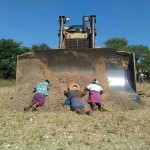ABSDF (1996) Cries From Insein
 Cries From Insein
Cries From Insein
by Win Naing Oo
Thse articles were published in 1996 by the ABSDF (All Burma Students’ Democratic Front).
1. Read > 1.1 Structure of the Prison
2. Read > 2.1 Prison Instruction Cell
3. Read > Corruption in the Prison
4. Read > Punishment in Prison
5. Read > Legal Procedures in Prison
6. Read > Criminal Prisoners
7. Read > Politicall Prisoners
8. Read > Harrassment of Politicall Prisoner
9. Read > General Issues
10. Read > Conclusion
1.1 Structure of the Prison
By Win Naing Oo
The prison is laid out in an octagonal design, with the halls located radially like the spokes of a wheel. There are two rows of brick walls around the prison. The external wall is higher about 20 ft in height, compared to the internal wall which is about 10 ft in height. There is also another prison known as the ‘attached prison’ which is joined to the main prison. The term ‘Insein’ is used to refer to both prisons. In order to enter the prison, it is necessary to pass through three thick iron doors in the entrance building. The Chief Warden of the prison lives on the upper floor of the building at the entrance. In the centre of the prison is the main prison office, and also the central tower. Taken in a clockwise direction, starting from the entrance building, the buildings in the prison are as follows (see the enclosed sketch of prison):
1. Entrance building (main iron gate of jail)
2. Female hall no.1
3. Solitary-confinement cell-blocks (there are six cell-blocks in compound)
4. Hall no. 1 (a two-story building, for detainees who are facing trial)
5. Hall no. 2 (a single-story building, also for detainees who are facing trial)
6. Hall no. 3 (for prisoners who have already been sentenced)
7. Special Hall
8. Hall no. 4 (for prisoners who have already been sentenced)
9. Hall no. 5 (for prisoners who have already been sentenced)
10. Kitchen hall
11. Hospital
12. Store
13. Prison office (reports and data on prisoners are kept here)
14. Female hall no. 2, including cell-blocks for women in solitary confinement
15. Attached prison
16. Office of the Prison Director-General (the head of all prisons in Burma)
17. Workshops
18. Dog-cell A.
Solitary Confinement Cells
There are six solitary-confinement cell-blocks. Each cell-block has many tiny cells (8 x 10). Each cell is shared by 3-5 political prisoners (since there are not enough cells for all the solitary-confinement prisoners, several prisoners are often kept together in these tiny cells). Prisoners in these cells are allowed to leave the room to wash and bathe for 15 minutes per day. Toilet buckets are cleaned every day.
No 1- Solitary confinement block 14 cells
No 2- 60 cells (including death row)
No 3- 14 cells
No 4- 30 cells
No 5- 22 cells
No 6- 10 cells
B. Other ordinary halls Each hall (25 x 440 ) has eight cells and has its own vegetable plots, one in front and one behind. Each vegetable plot is about fifty percent larger in area than the building itself.
C. Dog-cell The dog-cell is for the punishment of prisoners who commit a crime or who dare to complain about unjust treatment by prison authorities. (Previously, well-trained military dogs were kept in this cell, but there have been no dogs since 1988. Most of the worst atrocities take place in this cell. (See also 4. 1)
D. Special cell block This cell-block is only for very important political prisoners. It has 10 cells. Political prisoners who have stayed or are staying in this cell block are:
1. U Win Tin (Secretariat member of NLD)
2. U Khin Maung Mynt (Chairman of Peoples’ Progressive Party)
3. U Thet Khine (Main underground network network leader of CPB)
4. Min Ko Naing (Chairman of ABFSU)
There are four small houses in front of this special cell block. Political prisoners who have stayed in these small houses are:
1. U Tin Oo (Former Chairman of NLD)
2. U Kyi Maung (The Chairman of NLD following U Tin Oo)
3. U Chit Khine (Secretariat member of NLD)
4. Kim Min Chu (North Korean Operative) E.
Workshops
There are many workshops in the prison. Prisoners are forced to work long hours weaving, sewing (clothes and shoes) and working in the carpentry sections there.
1.2 Numbers of Prisoners
Hall no. 1 has two stories. There are nomally over 2,000 prisoners kept there. The other four halls always contain ove 1,000 prisoners each. There are routinely 400-500 political prisoners kept in the six solitary confinement cell blocks in the compound.
Thus the total estimated number of prisoners is:
Five ordinary halls 7,000
Six solitary confinement cell blocks 500
Female hall 500
Hospital 200
Attached prison 1,000
TOTAL 9,200
The number of prisoners in Insein prison varies slightly according to the situation. However, there are always 9,000-10,000 prisoners there. The solitary confinement cell blocks contain only political prisoners, all of whom are charged under section 5-j, but the rest of the political prisoners are mixed with criminals in Halls no. 3, 4 and 5. Each ordinary cell block always contains over 200 political prisoners.
Accordingly, the estimated numbers of political prisoners are:
6 solitary confinement cell blocks 500
3 ordinary cell blocks 700
Female hall and cell block 200
Attached prison 200
TOTAL 1,600
1.3 Prison Administrative Body
Chief Warden (Chief Supervisor of jail) One crown and two stars
Warden of jail 1 (Senior Supervisor) One crown and one star
Warden of jail 2 (Junior Supervisor) Three stars
Sr. Jailer (Senior prison officer) Two stars
Jr. Jailer (Junior prison officer) One star
Sergeant Major
Sergeant
Corporal
Lance Corporal Warder
The positions above are listed in descending order of rank. All positions are filled in Insein prison, but some of these ranks are vacant in other prisons in Burma. In addition, there is another authoritarian body made up of prisoners appointed by the prison administrative body:
Tan See Gyoke: The most senior person among prisoners.
Tan See: The most senior prisoner in a hall.
Akhan Lu Gyi: The most senior prisoner in a cell.
Akhan Sa Yei: Cell clerk; one in each cell. Varyar: The lowest level of these prisoners to managesecurity in cells, bathing and latrines.
The Tan See Gyoke and Tan See are criminals such as prominent gangsters and are appointed by the prison administrative body for this reason. All prisoners are very scared of them. A few prisoners become Akhan Lu Gyi by paying a bribe to the prison officials, but most of them are appointed because they are ruthless and brutal.
Rights of Prisoners and Violation of these Rights
2.1 Prison Instruction Cell
By Win Naing Oo
Red more …. Download PDF Cries From Insein


